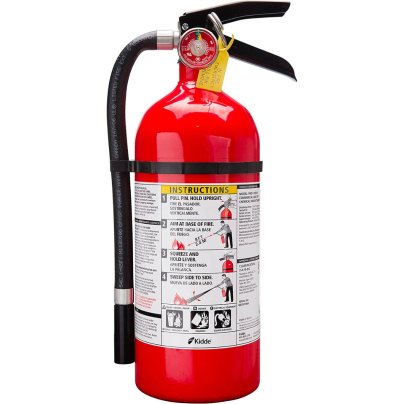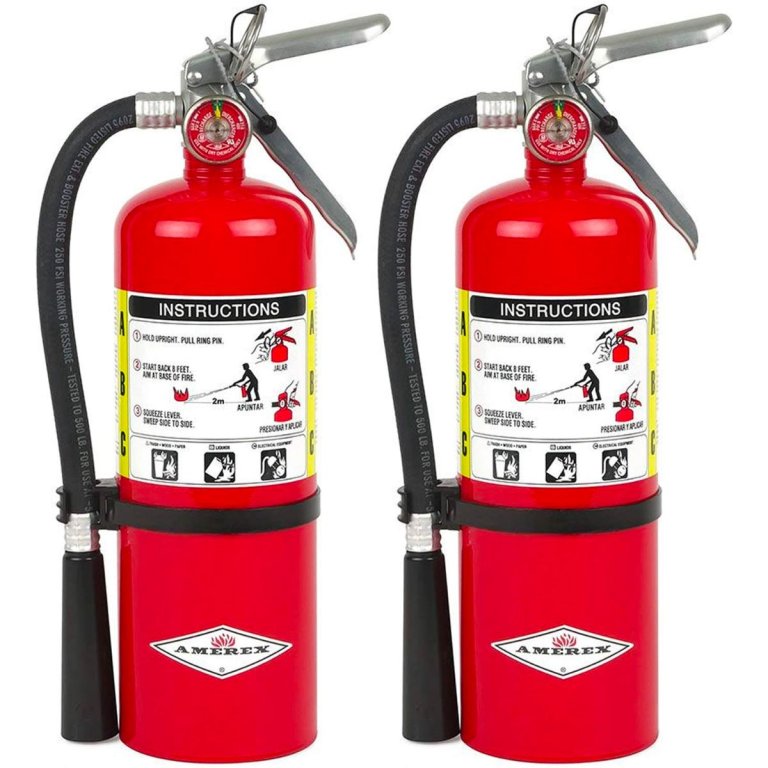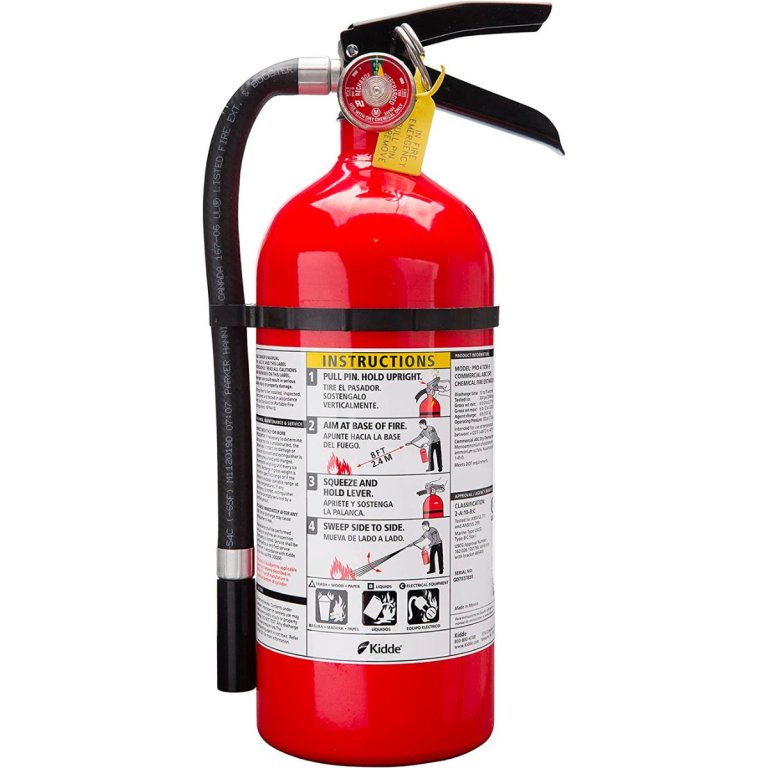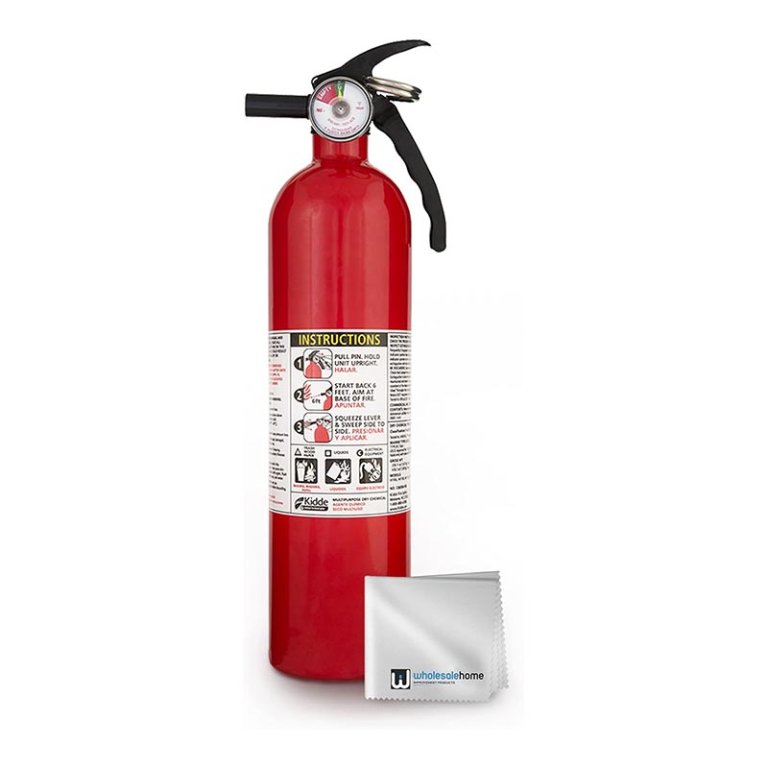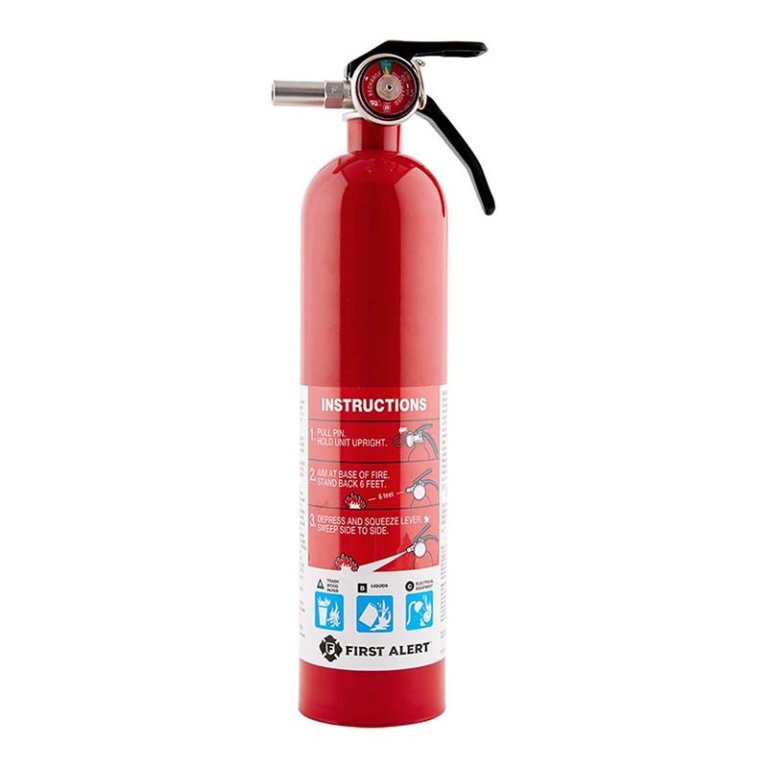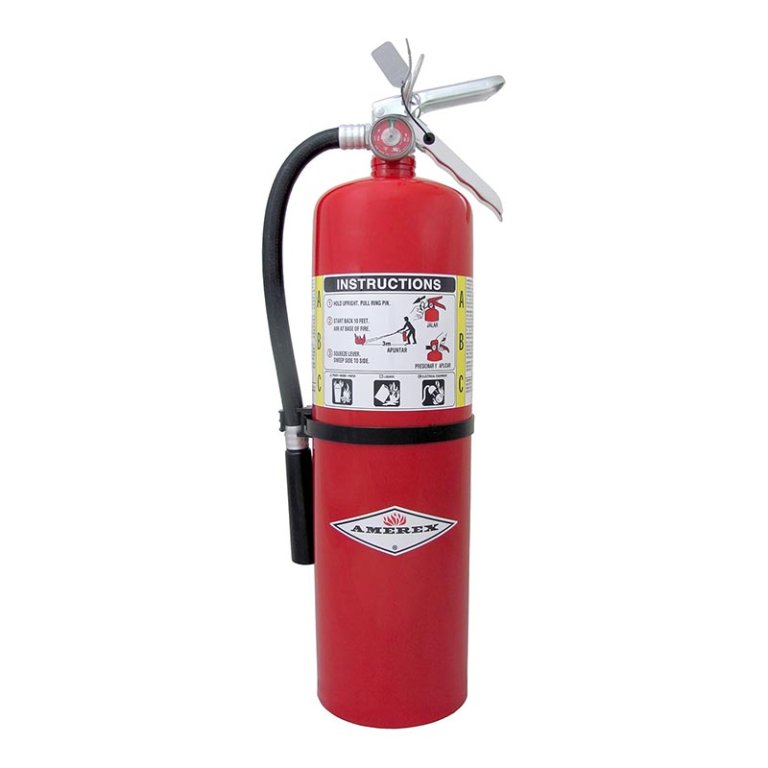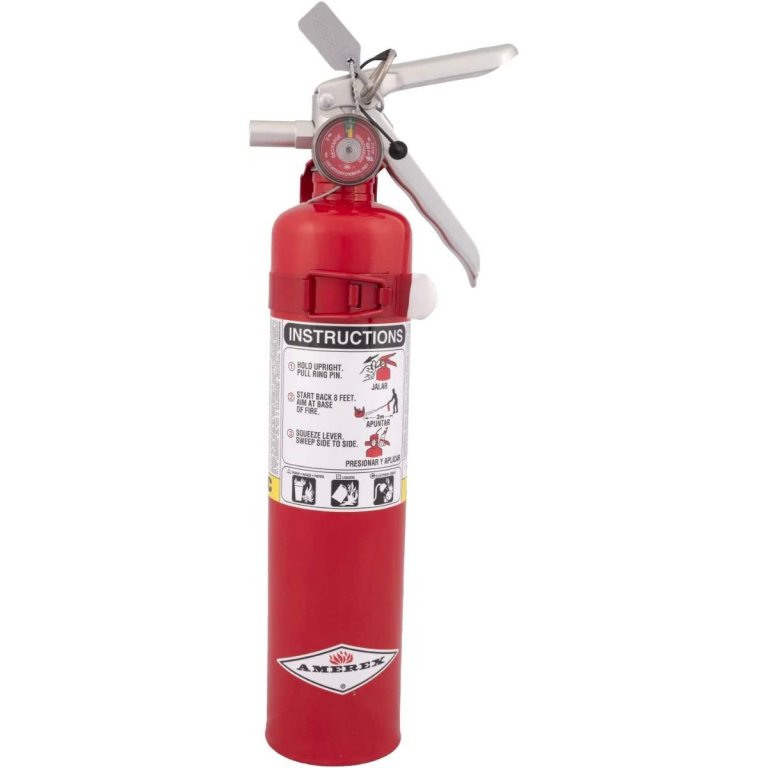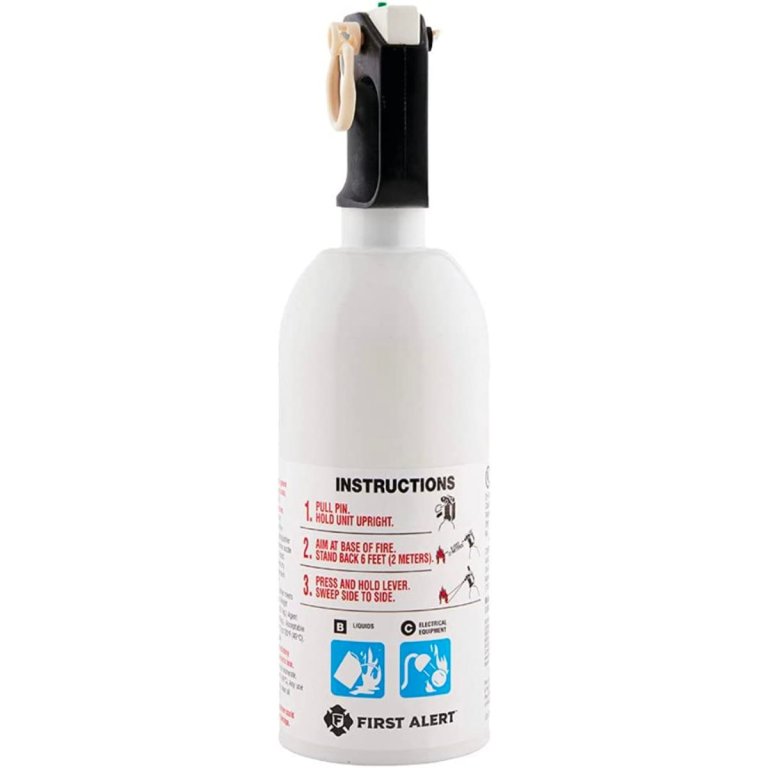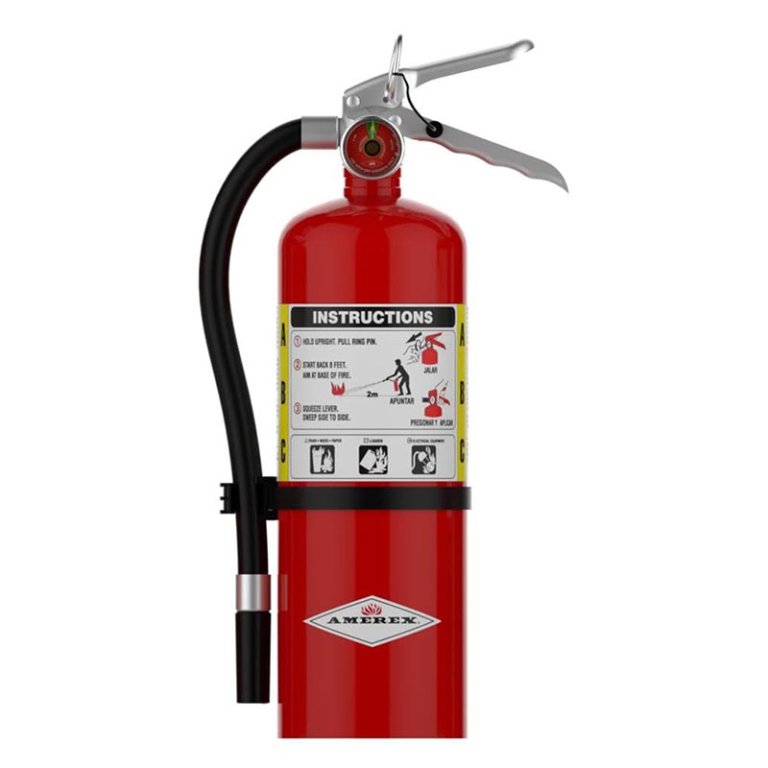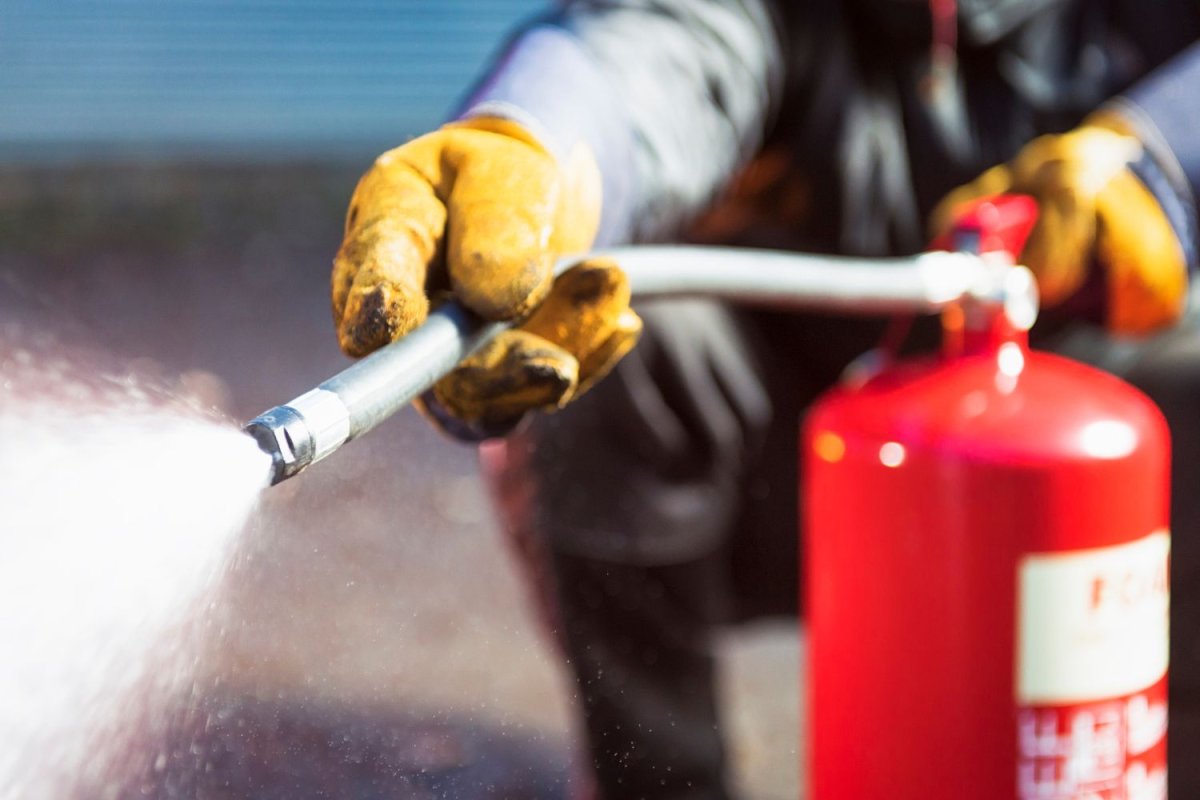
We may earn revenue from the products available on this page and participate in affiliate programs. Learn More ›
House fires are not uncommon and can have life-threatening consequences. Quick action taken with a fire extinguisher and/or fire escape ladder will help protect the lives of household members, in addition to reducing the risk of sustaining significant damage to the dwelling. Having a fire extinguisher in the home is also required by law in many states.
It is important to note that commercial and residential fire extinguishers may not put out a fire completely. An extinguisher can put out small fires, or contain them before the firefighters arrive, as those in the home move to a safe area. While people may be able to put out small fires quite safely, serious injury or death can occur by attempting to put out a fire that is beyond the capabilities of a fire extinguisher. People should only tackle a fire if it’s in its very early stages.
We sought out Jay Flynn, a fire chief in North Carolina (who is also foundation director for the real estate company Homes for Heroes), for expert advice on what to do when a fire breaks out in the home. “Never put yourself in harm’s way to use the extinguisher,” he says. “The most important actions are to call 911 as soon as possible to get the fire department coming and alert others so they can evacuate.”
A reliable extinguisher in the home can help address a fire emergency if it arises, and even if household members never have to use a fire extinguisher, this tool offers peace of mind. There are many extinguishers on the market, each intended for specific types of fires. Read on for help choosing the best fire extinguisher for a particular situation. In this guide, we outline classes of fires and corresponding extinguishers, offer shopping considerations for extinguishers, and give recommendations for top-performing models to help folks incorporate the best fire extinguisher into a home’s fire safety plan.
- BEST OVERALL: Amerex 5-Pound B500 ABC Fire Extinguisher
- RUNNER-UP: Kidde Pro 210 4-Pound ABC Fire Extinguisher
- BEST BANG FOR THE BUCK: Kidde FA110 Multipurpose Fire Extinguisher
- EASIEST TO USE: First Alert Rechargeable HOME1 Fire Extinguisher
- BEST CAPACITY: Amerex 10-Pound B456 ABC Fire Extinguisher
- BEST FOR THE CAR: Amerex 2.5-Pound B417T ABC Fire Extinguisher
- BEST FOR THE KITCHEN: First Alert Kitchen5 Fire Extinguisher
- BEST FOR ELECTRICAL FIRES: First Alert PRO5 Heavy Duty Plus Fire Extinguisher
- BEST FOR GREASE FIRES: Amerex 5-Pound B402 ABC Fire Extinguisher
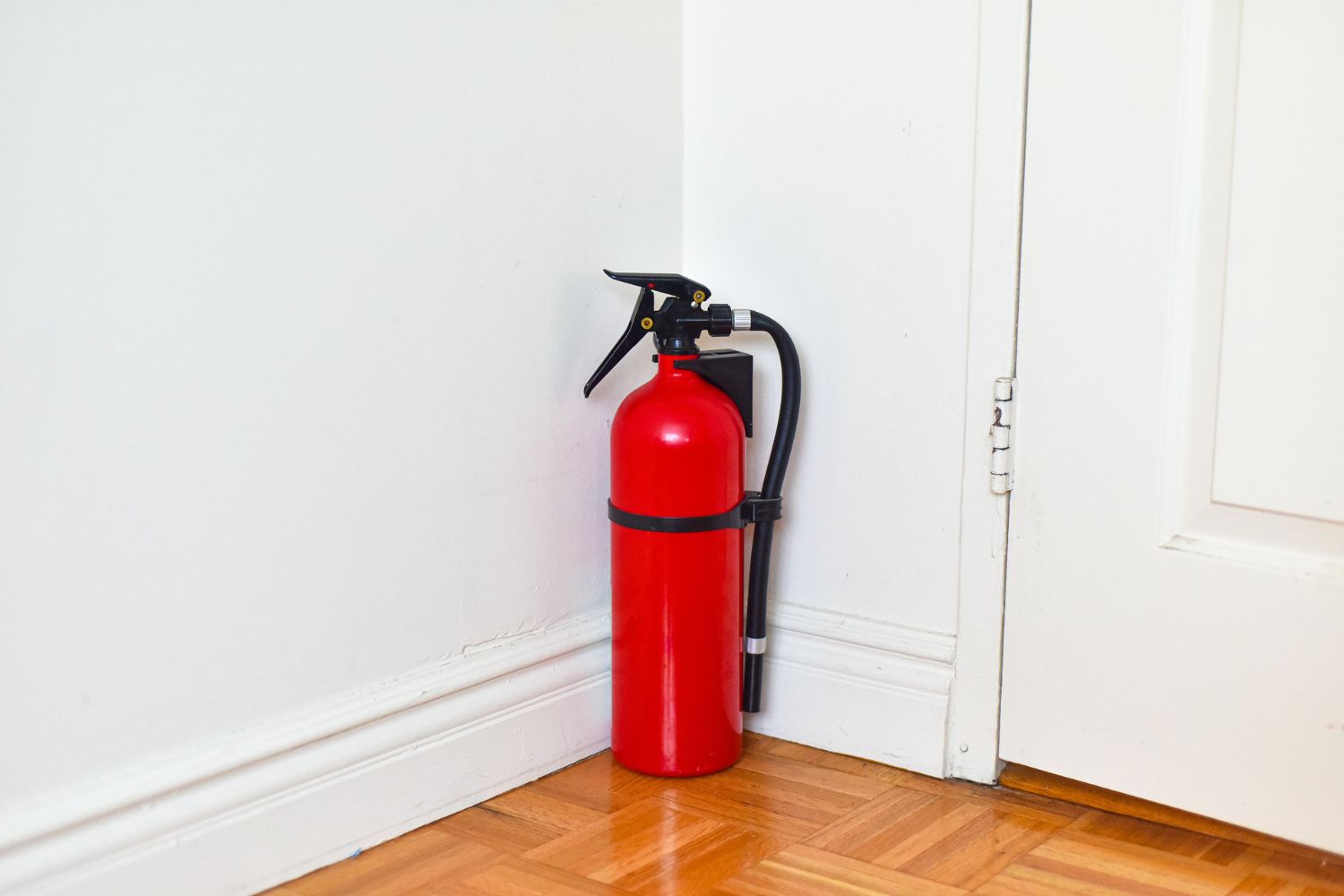
How We Chose the Best Fire Extinguishers
We researched the most sought-after commercial and residential fire extinguishers for emergencies in their respective categories and discovered that the best models are determined by their compatible fire class, size and weight, and other special features included by top brands.
“Homeowners must use the correct type of extinguisher to be effective,” counsels Flynn, who recommends an ABC-style extinguisher for most residences. “These are typically dry-chemical extinguishers that give the most flexible usage,” he says. With that in mind, we mainly chose extinguishers compatible with A-, B-, and C-class fires (explained in the section Classes of Fire Extinguishers that appears after our product reviews), meaning they can take on small kitchen fires as well as larger backyard or camping fires. We also chose models in a range of sizes and weights to suit various users and situations, from 2.5-pound models to those weighing 10 pounds or more. Plus, some models have tanks made with lightweight aluminum to be easy to grab quickly and use comfortably.
As for added safety features, we made sure to select user-friendly fire extinguishers with color-coded or large pressure gauges, instruction manuals, and wall brackets to prevent unwanted spraying while being stored.
Our Top Picks
Now it’s time to explore some top models. The following lineup offers fire extinguishers suited to the most important locations in a home, and in sizes that people can handle easily.
Best Overall
Amerex 5-Pound B500 ABC Fire Extinguisher
Pros
- Suitable for most common household fires; wall brackets are included
- Easily observed pressure gauges assure user that the extinguisher is in working order
- Includes rubber hose that can be directed right onto the fire without tilting the canister
Cons
- Some users report that the item arrived below charge and needed to be replaced
Product Specs
- Fire class: A-, B-, and C-class
- Size: 15.25 inches tall by 7.25 inches wide by 4 inches deep
- Weight: 5-pound capacity (9.25 pounds total)
Those looking for a reliable extinguisher to tackle the most common house fires will want to consider the B500 model from Amerex. This is a tried-and-true extinguisher, trusted by fire safety professionals. This set comes with two commercial-grade extinguishers as well as wall brackets for both. These extinguishers are suitable for A-, B-, and C-class fires, making them ideal for any room in the house.
Each extinguisher holds 5 pounds of ABC dry chemical, and the rubber hose is easy to aim at the base of the fire, allowing users to sweep a direct path in front of themselves. The extinguishers have easy-to-see pressure gauges to show if they’re still in working order. Folks who prefer to have extinguishers maintained can take these serviceable models to a local fire safety supplier.
Get the Amerex B500 fire extinguisher at Amazon (2-pack), The Home Depot, Walmart, or Amerexfireextinguishers.com.
Runner-Up
Kidde Pro 210 4-Pound ABC Fire Extinguisher
Pros
- Holds 4 pounds of dry chemical powder; rechargeable and can be used multiple times
- Easy-to-read pressure gauge so users can ensure the extinguisher is operational
- Rubber discharge hose makes pointing and aiming easy when putting out a fire
Cons
- Some users report the included plastic wall bracket is not very sturdy
Product Specs
- Fire class: A-, B-, and C-class
- Size: 15.7 inches tall by 4.5 inches wide
- Weight: 4-pound capacity (7.5 pounds total)
Kidde has been a leader in fire safety for over 100 years, and the company’s extinguishers are top-notch. The Kidde Pro 210 has an aluminum bottle, rather than steel, to help reduce weight and make this extinguisher more maneuverable. It holds 4 pounds of powder and features an easy-to-read pressure gauge to alert household members when the pressure drops.
The Kidde also includes a rubber discharge hose to help aim the suppressant powder at the base of the fire. This ABC extinguisher is appropriate for most household uses and comes with a wall bracket for hanging. The extinguisher is conveniently serviceable and can be maintained by bringing it to an extinguisher service shop.
Get the Kidde Pro 210 fire extinguisher at Amazon, The Home Depot, Walmart, or Kidde.
Best Bang for the Buck
Kidde FA110 Multipurpose Fire Extinguisher
Pros
- Lightweight and easy to grab quickly during a fire emergency
- Built-in gauges ensure that this compact fire extinguisher is operational
- Can be stored in small places including cars, trucks, RVs, kitchens, garages, and laundry rooms
Cons
- May not be suitable for extinguishing a large household fire
Product Specs
- Fire class: A-, B-, and C-class
- Size: 14.2 inches high by 4.5 inches wide by 3.6 inches deep
- Weight: 2.5-pound capacity (3.9 pounds total)
It’s not always feasible to mount a 5- or 10-pound fire extinguisher to a cabinet or a wall. In such cases, this lightweight ABC extinguisher from Kidde is a great choice for multipurpose fire protection. Plus, its affordable price makes it a solid choice for a backup extinguisher that can bring additional peace of mind.
Weighing 3.9 pounds, Kidde’s FA110 fire extinguisher covers most household needs, and its small size makes it easy to aim. The extinguisher can be stored in areas most vulnerable to fire, including cars and trucks, RVs, kitchens, garages, the laundry room, or an upstairs hall closet.
Get the Kidde FA110 fire extinguisher at Amazon, Walmart (2-pack), or Kidde.
Easiest To Use
First Alert Rechargeable HOME1 Fire Extinguisher
Pros
- Lightweight and easy to maneuver due to small size
- Sturdy metal head is tough and designed to hold up to multiple uses
- Rechargeable, so it can be used more than once (after professional recharging)
Cons
- Some reviewers report the extinguisher losing charge too quickly over time
Product Specs
- Fire class: A-, B-, and C-class
- Size: 14.25 inches tall by 3.25 inches wide
- Weight: 2.5-pound capacity (5.4 pounds total)
Lightweight and with a simple design, the First Alert HOME1 fire extinguisher is easy to use but still very effective. Like many of the others on this list, it’s an ABC extinguisher, so it can help put out small, common household fires. It’s a 2.5-pound-rated extinguisher, at a total of 5.4 pounds, and boasts a sturdy handle making it easy to maneuver.
There’s no hose to deal with on this extinguisher; to use, simply point the nozzle at the base of the fire and shoot. A durable metal head means this extinguisher meets demanding needs, and it’s rechargeable, too, so it can be employed more than once (it must be recharged by a professional after each use). A mounting bracket is also included.
Get the First Alert HOME1 fire extinguisher at Amazon, Lowe’s, Walmart, or Target.
Best Capacity
Amerex 10-Pound B456 ABC Fire Extinguisher
Pros
- Large-capacity 10-pound rating is a better choice for larger home fires
- Not too heavy overall; weighs 18 pounds, which is reasonable to lift for many users
- Metal mounting bracket is sturdy and long lasting, well suited to this heavier extinguisher
Cons
- This extinguisher might be too heavy for some, especially since it requires lifting with 1 hand
Product Specs
- Fire class: A-, B-, and C-class
- Size: 20 inches tall by 7.75 inches wide by 5 inches deep
- Weight: 10-pound capacity (18 pounds total)
While there are home fire extinguishers with a 20-pound rating, these can be unwieldy and difficult for some people to use. Fortunately, 10-pound-capacity options are often enough for home use. The Amerex B456 fire extinguisher fits the bill, and with an overall weight of 18 pounds, it’s not terribly heavy.
As an ABC extinguisher, it’s suitable for inside the home, garage, workshop, and more; simply place it where there are any concerns about a larger-than-normal fire. A large loop pull pin ensures easier use, and this extinguisher has a spray hose to improve aim. A sturdy metal wall bracket is included for reliable storage.
Get the Amerex B456 fire extinguisher at Amazon, The Home Depot, Walmart (2-pack), or Amerexfireextinguishers.com.
Best For The Car
Amerex 2.5-Pound B417T ABC Fire Extinguisher
Pros
- Small enough to keep in a car’s front seat, back seat, or trunk
- Comes with a bracket that can be screwed to the body panel
- Best for extinguishing fires that are small or at close range
Cons
- Smaller than comparable fire extinguishers; doesn’t include a hose, which may make aiming difficult for some people
Product Specs
- Fire class: A-, B-, and C-class
- Size: 15.5 inches high by 5.75 inches wide by 3 inches deep
- Weight: 2.5-pound capacity (5.5 pounds total)
Keeping a fire extinguisher in a vehicle is a very sensible precaution. The B417T ABC extinguisher from Amerex is a 2.5-pound model that fits under a passenger seat or in the trunk of a car without issue. There’s no hose to aim, but at this small size, pointing the device directly at the base of a fire isn’t a challenge.
It comes with an excellent bracket that can be screwed directly onto a body panel, latching it securely in place. This bracket keeps it from accidentally discharging in the vehicle and obstructing the driver’s view with a dry chemical, as well as preventing it from becoming an airborne safety hazard in an accident.
Get the Amerex B417T fire extinguisher at Amazon, Grainger, or Amerexfireextinguishers.com.
Best For The Kitchen
First Alert Kitchen5 Fire Extinguisher
Pros
- Small enough to store under a sink or cabinet; includes small bracket for safe storage
- Uses dry chemical BC powder; removes oxygen and contains fires quickly
- Easy-to-read color-coded push-button pressure gauge is corrosion-resistant and provides accurate measurement
Cons
- Not suitable for Class A fires, which involve combustible materials, including cloth, wood, and plastics
- Smaller than comparable options; suitable for small fires no larger than grease fires
Product Specs
- Fire class: B and C
- Size: 10.1 inches high by 3 inches wide
- Weight: 1.4-pound capacity (3 pounds total)
Never attempt to put out a kitchen fire with water. Doing so is likely to spread grease and cooking oil, potentially worsening the fire; water might also splash on an electric appliance, which can shock the user upon contact. The First Alert Kitchen5 fire extinguisher sidesteps these problems, holding just under 1.5 pounds of dry chemical BC powder—typically enough to put out a small grease fire.
This handy device is small enough to keep close by in the kitchen and lightweight enough to grab and aim to suffocate a fire. It comes with a small bracket that can be easily installed inside of a cabinet or pantry space. It has a color-coded push-button pressure gauge.
Get the First Alert Kitchen5 fire extinguisher at Amazon, Lowe’s, or Walmart.
Best For Electrical Fires
First Alert PRO5 Heavy Duty Plus Fire Extinguisher
Pros
- All-metal bottle, head, and valve provides ample durability
- Rechargeable and can be reused; heavy-duty construction is meant for demanding needs
- Easy-to-read color-coded corrosion-resistant pressure gauge
Cons
- This model is somewhat heavier than comparable options on the market
Product Specs
- Fire class: A-, B-, and C-class
- Size: 16.2 inches high by 4.6 inches wide by 6 inches deep
- Weight: 5-pound capacity (10.2 pounds total)
The First Alert PRO5 is a great choice for those looking for a reliable fire extinguisher for household use, electrical fires included. This 5-pound-rated and Underwriters Laboratories (UL)-rated extinguisher has an all-metal bottle, valve, and head, making it durable and long lasting. Plus, this model can be recharged by a certified professional for long-term reuse.
This heavy-duty top pick also comes with a mounting bracket and an easy-to-read color-coded corrosion-resistant pressure gauge so users can always know if the extinguisher is operational. Finally, this extinguisher is rated 3 A: 40 B:C and exceeds minimum 2 A:10 B:C code requirements. It’s suitable for electrical fires and more, including wood, paper, fabric, grease, and flammable liquid fires.
Get the First Alert PRO5 fire extinguisher at Amazon, Lowe’s, or Walmart.
Best for Grease Fires
Amerex 5-Pound B402 ABC Fire Extinguisher
Pros
- ABC fire extinguisher, suitable for home grease fires and other common fires as well
- Flexible rubber hose makes it easier to aim at the fire
- Has a range up to 18 feet so users can keep a safe distance from flames
Cons
- Some reviewers report receiving extinguishers with the safety pin missing
Product Specs
- Fire class: A-, B-, and C-class
- Size: 15.25 inches tall by 7.25 inches wide by 4.25 inches deep
- Weight: 5-pound capacity (9.25 pounds total)
Kitchens are a common location for house fires to start, and any fire extinguisher for a kitchen should be rated for class B fires. These extinguishers are safe to use on residential cooking oil and grease fires. But this Amerex model covers more than just grease fires, since it’s another ABC extinguisher.
It has a 5-pound capacity, so it’s suitable for in-home use, and weighs just under 10 pounds, making it easier to grab in an emergency. A rubber hose helps the user aim directly at the fire, and with a 12- to 18-foot range, the operator needn’t get too close to the grease fire to extinguish it.
Get the Amerex B402 fire extinguisher at Amazon, The Home Depot, Walmart, or Amerexfireextinguishers.com.
Jump to Our Top Picks
What to Consider When Buying a Fire Extinguisher
When adding a fire extinguisher to a home emergency safety plan, there are some important factors to keep in mind. Take note of these shopping considerations to help find the most appropriate fire extinguisher for a particular household.
Classes of Fire Extinguishers
There are four classes of fires that occur within the home, which are categorized based on the source of the fire. All fires require fuel to combust, and oxygen is necessary for most combustion reactions to occur. By smothering the flames, most extinguishers work to cut the fuel off from the oxygen around it, either to put out or contain the fire.
Household fire extinguishers consist of a pressure tank containing a propellant gas and a separate chamber for a suppressing agent. They come in four classes, corresponding to the classes of fires. Extinguishers can contain water, powder, foam, or nonflammable gas to smother the flames, depending on the source of the fire.
It is highly important to choose the right type of fire extinguisher for a home. Using the wrong type of suppressing agent can be ineffectual at containing the fire, or may worsen it. Read on to learn about the different classes of fires in the home and the extinguishers that help to put them out.
Class A
Class A fire extinguishers correspond with Class A fires, which contain ordinary combustible materials. A candle knocked over a piece of furniture or a partially lit cigarette burning in a trash can are two common examples of Class A fires. These fires often include materials such as:
- Paper
- Wood
- Fabrics
- Rubber
- Plastics
Nonchemical Class A extinguishers use water to extinguish fires. Other extinguishers in this category contain a monoammonium phosphate foam or powder to suffocate the fire. These extinguishers do not instantly cool a fire; they simply remove oxygen. For this reason, if the burning material is jostled or stirred, as can be the case if the fire appears to have been extinguished, there’s potential for a second flare-up.
Class B
Class B fires call for extinguishers that contain fires that have been caused by flammable liquids and chemicals, including cooking grease and oils, though only if these kitchen fires are of a small scale. They’re most common in garages and workshops as well as boilers and furnace rooms. Class B fires often include combustibles such as:
- Oils
- Solvents
- Petroleum greases
- Tars
- Lacquers
- Alcohols
- Gasoline/propane/natural gas/kerosene
Since these fires are often liquid in nature, attempting to smother them is not feasible—they’ll simply spread before the chemical can block out the oxygen. Instead, Type B fire extinguishers use a sodium bicarbonate foam or powder, which induces a chemical reaction that extinguishes the fire.
Class C
Class C fires need extinguishers for fires that occur when an electrical device or wiring ignites. It’s important to understand that if a device is energized (still plugged in or powered by a battery), it requires a different approach to extinguish it safely. Class C fires involve devices including:
- Computers
- Televisions
- Data equipment
- Transformers
- Motors
- Other appliances
Spraying water on a Class C fire can lead to disastrous results, as there is the potential for electrocution. For this reason, Class C extinguishers typically use nonflammable carbon dioxide gas to smother and cool an electrical fire, providing enough time for someone to deactivate the power source, if the fire is in its early stages.
Class D
Class D extinguishers deal with an uncommon type of fire in the home, though these fires do occur. Class D fires involve combustible metals, which are highly reactive with water. Attempting to put a metal-induced fire out with a water source can cause violent explosions and lead to the fire spreading to other nonmetal combustible materials nearby. Fires in this class most often involve a fuel source such as:
- Magnesium
- Titanium
- Lithium
- Potassium
To fight a Class D fire, the extinguisher requires a chemical that removes oxygen from the equation but will not react with metal. Class D extinguishers use powder forms of graphite, sodium chloride, or copper. These materials smother the burning material, preventing oxygen from getting to the fuel source.
Multi-Class
Multi-class extinguishers are formulated to extinguish or contain fires in two or more classes. ABC fire extinguishers are commonly placed in the home and in vehicles to address the corresponding three classes of fire. BC fire extinguishers are appropriate for kitchens, workshops, garages, and boiler rooms, since these areas often have the potential for both chemical or liquid fires, as well as electrical.
Type and Location of Fire
The location and types of fire are very important considerations when choosing the best fire extinguisher. An ABC extinguisher will effectively extinguish or contain fires in most places inside of the home. These extinguishers can handle most combustible materials, with the exception of flammable metals, and provide members of the household with enough time to get to safety. In short, ABC fire extinguishers can tackle some of the most common fires in the home.
B and C or BC extinguishers can tackle most kitchen fires, but there are still elements worth thinking about. For one, most folks don’t want a fire extinguisher on display in their kitchen, so they’ll need to find a place to mount an extinguisher that is close by and easily accessible while out of sight. Also, kitchen fires are usually on stoves or countertops, and a large fire extinguisher can be difficult to lift that high for some people. For both of these reasons, a small fire extinguisher that is kept in a kitchen cabinet and is easy to use on a stove is the best way to go.
Placement
The National Fire Protection Association suggests that families locate fire extinguishers where they are easy to grab within seconds. Fires can double in size every 30 seconds, so it’s important to get to them quickly. Central locations like hallways and main living spaces are ideal locations. There should be at least one fire extinguisher on every floor of a home. On the main floor, the most important location is the kitchen, one of the most common places for fires to begin.
Pro Tip: Don’t install or keep a fire extinguisher above or next to the stove. As this is the most likely place for a fire to begin, a blaze will make it difficult for someone to reach the extinguisher. Instead, place the extinguisher a few feet away from the stove so that someone can easily take those few steps back and grab the extinguisher.
Maintenance and Refills
Just like a smoke detector, fire extinguishers do require maintenance, including refills. Professional fire extinguisher inspectors check commercial extinguishers annually and improve the available models approximately every 6 years. The inspectors check the pressure gauges and “thump” the bottom of dry chemical extinguishers to loosen up the settled powder. Fire extinguisher inspectors also have the bottle pressure tested to ensure there are no leaks.
These are good policies to follow with a home fire extinguisher. Note that commercial-grade extinguishers are generally easy to service and refill, while homeowner-style extinguishers typically are neither; these models tend to be of lesser quality. Fire extinguishers don’t really have a strict expiration date, so it’s most cost-effective to simply replace them around every 10 years (and to recharge rechargeable fire extinguishers every 6 years).
Size and Weight
Fire extinguishers come in a variety of weights, such as 2.5, 4, 5, 10, and 20 pounds. These values represent how much suppressing agent the bottles hold. The additional weight of the bottle, stem, head, and hose are not factored into the weight.
For most household purposes, 5-pound fire extinguishers are sufficient. In a garage setting, it is better to use a 10-pound extinguisher since there are more combustibles in a garage (think chemicals, rags, and scrap wood). Compact, 2.5-pound extinguishers are perfect for vehicles.
When it comes to the physical bottles, they all have a similar shape and size relative to volume. While it may seem that bigger is better, large extinguishers can be challenging to store and handle. Finding an extinguisher that fits its intended location is key.
Tips for Using a Fire Extinguisher
While fire extinguishers put out fires, any local fire department pro will remind folks that if a home is on fire, users will want to employ the extinguisher to clear a path to safety for household members. Regardless of their size, fires are dangerous, and it’s best to get outside and allow professionals to handle the situation.
When using a fire extinguisher, follow the P.A.S.S. system:
- P – Pull the safety pin
- A – Aim the nozzle at the base of the fire
- S – Squeeze the handle (or trigger in some cases)
- S – Sweep back and forth with the nozzle, extinguishing the fire before escaping to safety
Only use a fire extinguisher once before discarding it or taking it for service. Dry chemical will cling to the grease on the valve seal and allow the nitrogen that charges the bottle to escape. Carbon dioxide detectors don’t use gauges, so people can’t be sure how well they’re charged or how full they are.
- Use a fire extinguisher to clear a path to safety
- Use the P.A.S.S. system to extinguish a fire
- Only use an extinguisher on time before replacing or servicing
FAQs
Below, find succinct answers to some of the most frequently asked questions regarding fire extinguishers. Those with more questions about this possibly life-saving device may wish to take the fire safety training course offered by many local fire departments. These courses are a great resource for learning about how to make and implement a fire safety plan, and the fire professionals ought to be more than happy to help and answer questions.
Q. What is inside a fire extinguisher?
Water, dry chemical powder, wet chemical foam, or carbon dioxide may be inside a fire extinguisher. It depends on the type of extinguisher.
Q. How do you use an extinguisher?
Use the P.A.S.S. system: Pull, Aim, Squeeze, Sweep. This is the best method for extinguishing a fire.
Q. How long does a fire extinguisher last?
Fire extinguishers have a usable lifespan of 5 to 15 years, but it’s better to take them for servicing earlier than this.
Q. How do you dispose of a fire extinguisher?
Take the used, empty extinguisher to a hazardous waste disposal center. To find a nearby location, contact your county office.

